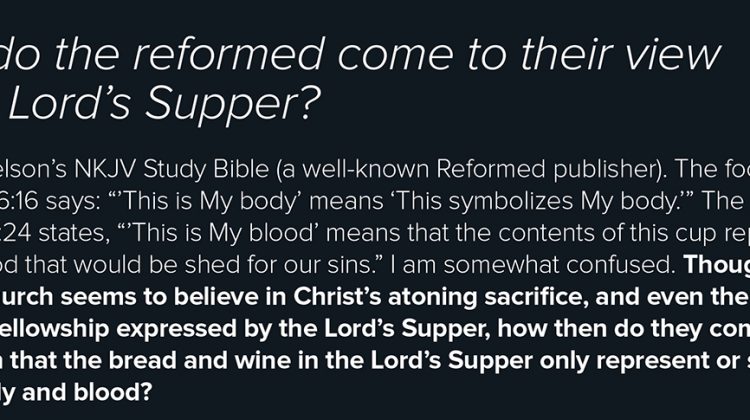
I have a Nelson’s NKJV Study Bible (a well-known Reformed publisher). The footnote to Matthew 26:16 says: “’This is My body’ means ‘This symbolizes My body.’” The footnote on Mark 14:24 states, “’This is My blood’ means that the contents of this cup represented Jesus’ blood that would be shed for our sins.” I am somewhat confused. Though the Reformed Church seems to believe in Christ’s atoning sacrifice, and even the unity of Christian fellowship expressed by the Lord’s Supper, how then do they come to the conclusion that the bread and wine in the Lord’s Supper only represent or symbolize Jesus’ body and blood?
Lutheran and Reformed Christians have debated the Lord’s Supper since the days of the Reformation. One of the most famous debates of that era, the Marburg Colloquy (CALL-oh-kwee), took place in 1529. There Martin Luther himself met with Ulrich Zwingli, the leader of the Anabaptists, in order to address the real presence of Christ’s body and blood in the Lord’s Supper. In the middle of the debate at Marburg, Luther famously pulled back the tablecloth where he was sitting, took a piece of chalk, and wrote on the table, “This is My body.”
Reformed Christians—those Christians who trace their theological heritage chiefly through Calvin and Zwingli—generally hold to two major arguments to explain their representational view of the Lord’s Supper. The first argument has to do with what Jesus said. The second has to do with where Jesus’ body is.
With regard to what Jesus said, Reformed theologians believe that, when He gave the words of institution, Jesus was speaking in metaphors. They will point to examples from John’s Gospel, where Jesus says, “I am the vine; you are the branches” (John 15:5). Clearly Jesus is not literally a vine growing in the garden but was only comparing Himself to one. So, on the night He was betrayed, when Jesus took bread and said, “This is my body,” He wasn’t saying that the bread was His literal body, but He was comparing His body to the Passover bread, which was about to be broken when He died on the cross the next day.
The other argument that Reformed theologians make about the Lord’s Supper deals with where Jesus’ body is. They teach that “the finite is not capable of the infinite.” Since Jesus’ body has ascended to heaven and is seated at God’s right hand, they reason, Jesus’ body and blood therefore cannot be present in the Sacrament of the Altar. In support of this line of reasoning, John 6:63 is often cited: “It is the Spirit who gives life; the flesh profits nothing.”
For those reasons, then, many Christians who otherwise take God’s Word at face value find themselves engaging in all kinds of verbal gymnastics in order to make the word “is” mean “represents” in the Lord’s Supper. Instead of a proclamation of the Gospel where God’s people receive the forgiveness of sins and are strengthened by it, with the Reformed interpretation, the Lord’s Supper becomes merely an ordinance to be kept, a fellowship meal where participants eat and drink in remembrance of Christ’s death for their sins.
This is why many Reformed churches still practice some measure of close communion and recognize the fellowship that takes place at the Supper, even though they do not acknowledge the presence of Christ’s body and blood! They still understand that at the Lord’s Supper, believers are professing their faith in Christ and expressing their unity in that faith with each other.
It’s worth noting that Scripture itself tells us what we receive when we come to the Lord’s table. In I Corinthians 10, the apostle Paul says, “The cup of blessing which we bless, is it not the communion of the blood of Christ? The bread which we break, is it not the communion of the body of Christ?” (10:16, NKJV). We do not commune with the bread and the cup, even though the bread and cup are still there. We commune with the body and blood of Christ.
The debate about the Lord’s Supper between Lutherans and the Reformed won’t be ending soon, but that doesn’t mean God’s Word hasn’t spoken clearly. Through the pages of Scripture, the Lord reveals the wonders of His sacrament and the assurance of His mercy and forgiveness, all wrapped up in the words of Jesus, “This is My body…”
Rev. S. Piet Van Kampen